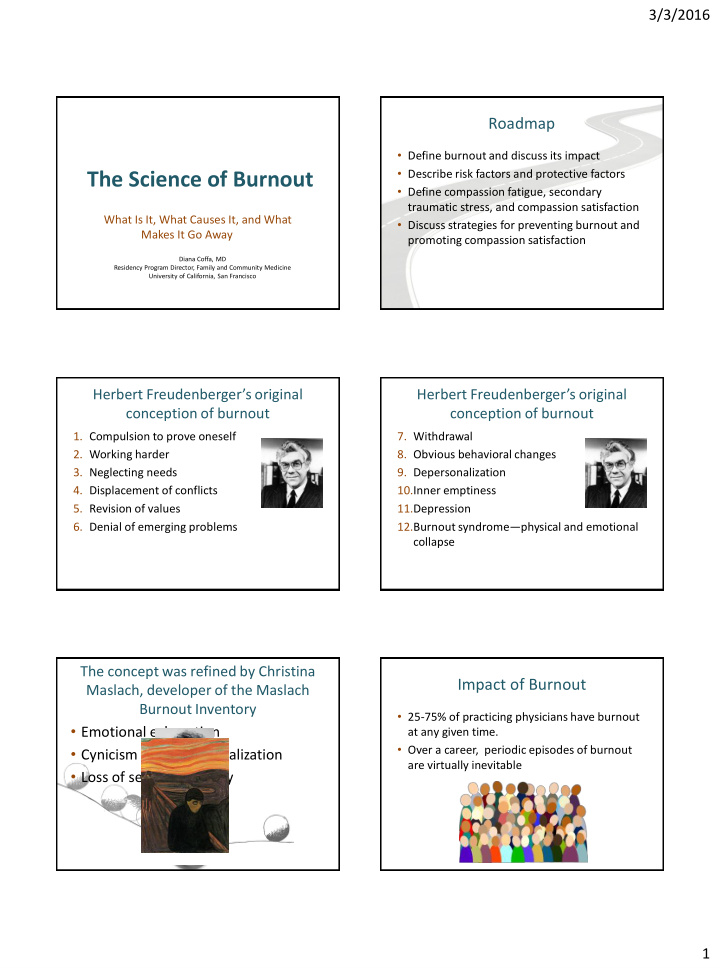



3/3/2016 Roadmap • Define burnout and discuss its impact • Describe risk factors and protective factors The Science of Burnout • Define compassion fatigue, secondary traumatic stress, and compassion satisfaction What Is It, What Causes It, and What • Discuss strategies for preventing burnout and Makes It Go Away promoting compassion satisfaction Diana Coffa, MD Residency Program Director, Family and Community Medicine University of California, San Francisco Herbert Freudenberger’s original Herbert Freudenberger’s original conception of burnout conception of burnout 1. Compulsion to prove oneself 7. Withdrawal 2. Working harder 8. Obvious behavioral changes 3. Neglecting needs 9. Depersonalization 4. Displacement of conflicts 10.Inner emptiness 5. Revision of values 11.Depression 6. Denial of emerging problems 12.Burnout syndrome — physical and emotional collapse The concept was refined by Christina Impact of Burnout Maslach, developer of the Maslach Burnout Inventory • 25-75% of practicing physicians have burnout • Emotional exhaustion at any given time. • Over a career, periodic episodes of burnout • Cynicism and depersonalization are virtually inevitable • Loss of sense of efficacy 1
3/3/2016 Impact of Burnout Adverse impacts spread Increased rates of Increased • Depression • Errors, both medical and surgical • Anxiety • Patient dissatisfaction • Suicidality • Postoperative recovery times • Increased inflammatory markers • Wound infections • Possible association with cardiovascular • Patient nonadherance disease • Increased sick calls • Attrition from medicine Other Models What is Compassion Satisfaction? The satisfaction derived from being able to help Secondary others. Traumatic Stress Compassion Satisfaction Compassion Fatigue “Incentivizing with money is a self -fulfilling prophecy of cynicism. We must promote compassion, courage, and wisdom among our physicians before we make a sordid business of this high and sacred calling.” Describe a time when you felt The Impact of Compassion Satisfaction compassion satisfaction at work • Studies on the impact of emotional attunement and engagement • What were the conditions that promoted it? – Higher adherence to medications and – Personal conditions recommendations – Environmental/professional conditions – Increased patient satisfaction – Increased placebo response • How can you build more of those conditions into your work? 2
3/3/2016 Risk Factors and Protective Factors Work Related Risk Factors Work Personal • Lack of control Risk • Heavy workload • Exposure to trauma Protection Risk Factors and Protective Factors Work Related Protective Factors • Shared mission Work Personal • Flexible schedule Risk Lack of control Heavy workload • Teamwork Exposure to trauma • Work friends • Supportive culture Protection • Teaching and administrative roles – Opportunity for sense of effectiveness in the short to mid term Risk Factors and Protective Factors Personal Risk Factors • Temperament and personality features Work Personal – Alexithymia Lack of control Risk Heavy workload • Life stress Exposure to trauma • Personal history of trauma • Approach to work Protection Shared mission Flexible schedule Teamwork Work friends Supportive culture Teaching and administrative roles 3
3/3/2016 Approach to work • Surface organized – Must be “just so” • Surface disorganized – Overwhelmed • Deep approach – Interested and engaged by complexity, problem solving McMannus IC et al. Stress , burnout and doctors’ attitudes to work are determined by personality and learning style: A twelve year longitudinal study of UK medical graduates. BMC Medicine 2004. 2:29 Personal Protective Factors Risk Factors and Protective Factors Work Personal • Cultivating relationships with patients Risk Lack of control Temperament and personality Heavy workload features • Cultivating relationships with colleagues Exposure to trauma Alexithymia Life stress • Social support Personal history of trauma Approach to work • Empathetic concern coupled with emotional Protection Shared mission Relationships with patients flexibility Flexible schedule Relationships with colleagues Teamwork Social support • Openness to new experience Work friends Empathetic concern Supportive culture Emotional flexibility • Deep approach to work Teaching and administrative Openness to new experience roles Deep approach to work • Self care practices Self care practices Self-care practices Meditation • Increased attentional control • Meditation • Increased ability to notice and accurately label emotions • Exercise • Decreased impulsive reaction to negative emotion • Outside interests • Shift from “brooding” or perseverative style to • Psychological practices “compassionate noting” style of awareness • Increased positive affective states • Therapy – Happiness, joy, love, gratitude, contentment, hope, • Micro-breaks interest, amusement, awe • Increased internal resources: • Vacations – greater purpose in life, improved resilience, enhanced optimism, greater mindfulness, more self-acceptance, more hope 4
3/3/2016 Psychological Practices • Gratitude list Far Enemy Near Enemy Compassion Cruelty Devastating • Taking in the good Grief/Pity • Perspective taking Loving-kindness Hate Desire • Deep breath Resonant Joy Jealousy Giddiness • Visualization Equanimity Agitation Apathy Micro-breaks Vacations • Short, dispersed throughout day • Reduced work related stress and burnout for • Work-related 1-2 months – Conversations with colleagues • Shorter if high workload upon return • Physical • Consider shorter, more frequent vacations – Walk down the hall – Stretch • Relaxing – Deep breath – Visualization – Words Your assignment • Notice the moments when you experience compassion satisfaction. • Take the time to soak it in when it happens. • Look for ways to build more in. 5
Recommend
More recommend